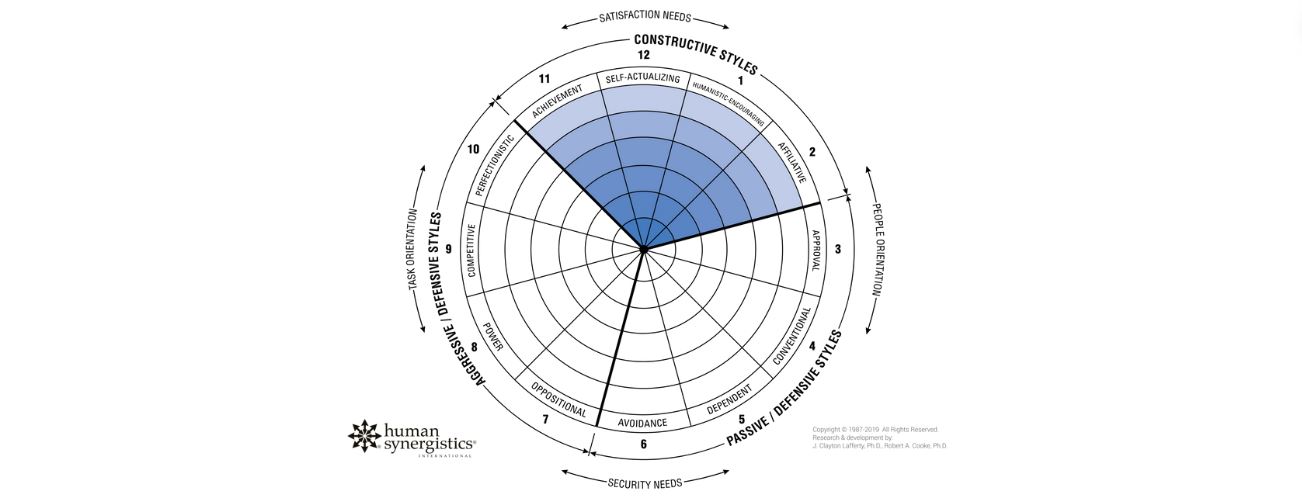Understanding the Constructive Cluster in the Group Styles Inventory (GSI)
High-performing teams don’t just have the right skills – they also have the right mindset and ways of working together. The Group Styles Inventory (GSI) by Human Synergistics helps teams uncover the thinking styles they bring to problem-solving and decision-making, and how those styles influence their results.
In this article, we’ll explore what the GSI measures, what the Constructive cluster is, the four styles it includes, and how teams can strengthen them for greater collaboration, creativity, and performance
What is the Group Styles Inventory (GSI)?
The Group Styles Inventory is a research-based team assessment that measures how members think and interact when solving problems together.
It looks at shared thinking patterns, not individual personalities – giving teams insight into the beliefs and behaviours they collectively demonstrate during tasks and meetings.
The twelve thinking styles are organised into three clusters:
-
Constructive – thinking that supports mutual respect, trust, and achievement.
-
Passive/Defensive – thinking that is self-protective and approval-seeking.
-
Aggressive/Defensive – thinking that is competitive, oppositional, and control-oriented.
By understanding their current styles, teams can make targeted changes to improve their problem-solving effectiveness, satisfaction, and outcomes.
What is the Constructive Cluster?
The Constructive cluster represents thinking styles where team members focus on achieving results while maintaining positive, respectful relationships.
These styles are associated with open communication, innovation, accountability, and collaboration – and they are consistently linked to high team performance.
The four Constructive styles are:
-
Achievement – Setting challenging yet realistic goals and working systematically to meet them.
-
Example: A project team defines clear milestones, tracks progress, and adjusts plans to meet a tough deadline without sacrificing quality.
-
-
Self-Actualising – Seeking personal growth, learning, and new experiences through teamwork.
-
Example: Team members volunteer for stretch assignments to build new skills while contributing to the group’s success.
-
-
Humanistic-Encouraging – Supporting and developing others, creating a climate of trust and cooperation.
-
Example: A team leader mentors a newer member to help them contribute confidently to discussions.
-
-
Affiliative – Building strong relationships and a sense of belonging within the group.
-
Example: A remote team sets time aside for informal catch-ups to maintain connection and trust across locations.
-
When teams operate in these styles, they typically enjoy higher engagement, stronger results, and better problem-solving quality.
5 Ways to Strengthen Constructive Styles in Your Team
Even if your GSI results already show strong Constructive thinking, it’s important to intentionally reinforce these styles so they become part of your team’s default way of working.
Here’s how:
-
Set and Review Shared Goals
-
Align the team on clear, challenging, and meaningful objectives.
-
Regularly review progress and celebrate wins together.
-
-
Create Space for Reflection and Learning
-
After key projects or meetings, discuss what worked well and what could improve.
-
Encourage members to share lessons learned without blame.
-
-
Recognise Contributions and Growth
-
Acknowledge both outcomes and effort – especially when someone takes on a challenge, learns a new skill, or helps another team member.
-
-
Encourage Inclusive Decision-Making
-
Actively seek diverse perspectives in problem-solving discussions.
-
Rotate facilitation roles so different voices help guide the process.
-
-
Model Respectful Challenge
-
Show that disagreement can be constructive by focusing on the idea, not the person.
-
This reinforces trust while keeping the focus on achieving the best result.
-
Conclusion: The Payoff of Constructive Thinking
The Constructive cluster in the Group Styles Inventory represents the gold standard for team thinking styles – balancing a focus on results with a commitment to relationships.
Teams that strengthen these styles consistently see better collaboration, stronger engagement, and higher-quality outcomes.
If you’re looking to assess and grow your team’s Constructive thinking, the Group Styles Inventory provides the insight and framework to help you get there – turning shared goals into shared success.
If you want to understand your team’s current styles and create a pathway to Constructive thinking, the Group Styles Inventory offers the insights and our consultants can help you with the strategies to help you get there.
